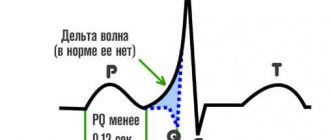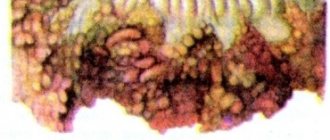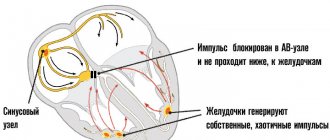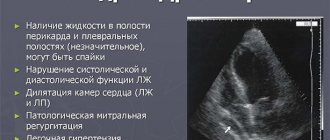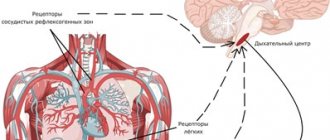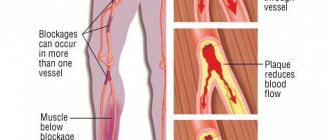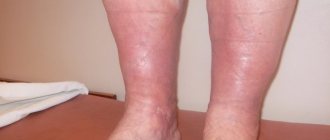Disorders of the functional activity of the central nervous system constitute a separate layer of diagnoses, an entire sphere of medical science and practice. Specific deviations have their own clinical manifestations and differ in prognosis, severity and danger.
Cerebrasthenic syndrome is a complex of intellectual-mnestic, behavioral, emotional and autonomic disorders; the lesion affects the brain and the main areas of human social activity as an additional factor.
This is not an independent diagnosis, as the name suggests. A syndrome is a group of manifestations that define individual diseases.
The pathological process is of organic origin and is always associated with structural changes in the brain.
In children it occurs several times more often due to the active ongoing development of the central nervous system, has an unstable course and generally more negative prognosis. Adults also suffer.
Cerebrasthenic syndrome (abbreviated as CAS) is always secondary to one or another abnormal process.
It responds well to treatment in the early stages, then all that remains is to “suppress” the symptoms and prevent further progression of the disorder. The forecasts in all cases are quite optimistic, with some reservations.
Development mechanism
This disorder is considered as part of a symptomatic complex of brain disorders.
The deviation does not have its own place in the international classifier, which is understandable. However, most often the diagnosis is made as a condition under ICD-10 code F06.6.
This is a kind of generalized subgroup, which is further subdivided in order to describe the condition even more accurately.
And this is where the difficulties begin. Because the mechanism is based not on one or even two factors, but on a huge possible group.
In any case, the beginning of the pathogenic process is organic damage to the brain. Exactly what kind depends on the case.
It could be:
- Intrauterine hypoxia (a common situation).
- Damage during the natural resolution of pregnancy, when passing through the mother's birth canal.
- Infectious lesions of cerebral structures, tumors, epileptic process, mental disorders, other somatic diseases.
There are a great many options; identifying a specific provocateur is a diagnostic task; without a clear understanding of the nature of the disorder, there can be no complete treatment. Doctors will be forced to deal with symptoms by repeating the course again.
Then the process loops. Organic disorders lead to changes in the functioning of the central nervous system, and weakening and chaotization of the functioning of cerebral structures further aggravates the changes.
The brain continues to transform abnormally, which is clearly visible from the results of objective diagnostics.
Over time, without treatment, irreversible changes occur in the cortex, hemispheres, and deep-lying structures. Recovery becomes basically impossible. You have to deal with the consequences. With varying success, such treatment has been carried out for years without guarantees.
Ultimately, disability may occur due to a critical disorder of the brain, mental deficiency and other factors, although this is extremely rare.
Deficiency phenomena occur in children many times more often; with an identical development mechanism, the prospects without quality treatment are much worse.
Symptoms of the disorder
With the asthenohyperdynamic variant of cerebrasthenia, fussiness, motor disinhibition and activity, restlessness, nervous excitability, aggression, and irritability predominate.
In the asthenoadynamic variant, lethargy, apathy, drowsiness, lethargy, and inactivity predominate.
General symptoms of cerebrospinal gravis:
- emotional instability, sudden mood swings, increased vulnerability and susceptibility to external influences, tearfulness, touchiness;
- increased fatigue and exhaustion of the nervous system;
- deterioration of memory and concentration;
- sleep disorders – insomnia or constant drowsiness;
- headaches, often accompanied by nausea, vomiting, increasing with fatigue and sudden movements;
- dizziness, fainting with darkening of the eyes and a feeling of severe physical weakness;
- poor tolerance to travel in transport, heat and stuffiness;
- sweating, lack of thermoregulation, fluctuations in body temperature, tachycardia;
- increased sensitivity to auditory, light and olfactory stimuli;
- long-term decrease in performance under intellectual load.
Symptoms of the syndrome in young children:
- motor restlessness;
- causeless crying, screaming;
- interrupted sleep;
- delayed formation of motor functions and speech development.
Symptoms in children of preschool and school age:
- in the motor sphere, two opposite options are possible: motor disinhibition or vice versa, lethargy and inertia;
- difficulties adapting to school;
- long-term persistence of speech defects;
- difficulties in developing reading, writing, and counting skills;
- poor memorization of educational material;
- intolerance to riding on carousels or swings;
- frequent causeless changes in mood, moodiness, dissatisfaction, melancholy.
Symptoms in adults
Manifestations of cerebrastia in mature people (this also includes teenagers from 13-15 years of age and beyond) are more stable and not so threatening.
Since the brain is mostly formed (the process ends on average by age 21-22), mental deficits are not as pronounced, but there are still a lot of impairments.
Headache
Not necessary. If they are, the intensity is minimal to medium. Much depends on the underlying diagnosis. Origin of pathology.
Localization - temples, back of the head, parietal region. More often, a diffuse, diffuse nature of pain is detected. All over my head at once.
Emotional lability
The patient becomes unstable. He is sometimes in high spirits, sometimes depressed and gloomy.
In all cases, there is an increase in irritability and aggressiveness for no apparent reason or outside motivation. After a sharp outbreak, the patient feels unprecedented fatigue and falls off his feet. He needs recovery.
Such jumps in the emotional background in the system with critical fatigue after an episode of anger clearly indicate CAS; sufferers are often in a depressed, almost depressive state all the time.
Absent-mindedness
Inability to concentrate normally on a subject, even with a strong desire.
It is part of the intellectual deficit, which becomes a faithful companion of the patient for many years, if specific treatment for the disorder is not carried out.
Severe fatigue
Even with minimal physical, much less mental, stress. The patient is unable to perform work duties. The ability to learn suffers, this is especially noticeable during school and student years.
Problems with household services are possible if the process has gone far enough to provoke such severe deviations in everyday life.
Insomnia
Inability to get a normal night's rest due to frequent spontaneous awakenings. Caused by a violation of the regulation of inhibition and excitation processes in the central nervous system.
Vegetative signs
They are almost always present, but not in all cases they arise immediately. Among these: palpitations, increased sweating, shortness of breath and other similar phenomena.
Deviations in the thinking process, memory loss
The person does not switch to another task so quickly and cannot do what he usually did with ease. It takes much more time.
Attention:
Intellectual deficit can be overcome at almost any stage of the disease.
Symptoms are caused by insufficient nutrition or ineffective functioning of cerebral structures.
Intellectual and behavioral deviations become the result of a complex compensatory mechanism. The brain tries to reduce the need for nutrition and breathing, reducing the potential for its own work. Therefore, habitual actions are difficult to perform.
Cerebrasthenic syndrome: symptoms and treatment – Suppressed
- Psychotherapist of the highest category Oleg Viktorovich
- 49815
- Update date: October 2019
Cerebrasthenic syndrome is a neurological disorder characterized by a decrease in the ability for mental work and learning.
It occurs in people of any age, including children and adolescents. The disease develops mainly due to organic damage to the brain.
Cerebrovascular disease requires timely consultation with a doctor and comprehensive treatment, otherwise the pathology negatively affects the patient’s quality of life and professional activity.
The essence of the violation
Since the main characteristic of cerebrasthenia is a violation of adaptive mechanisms, the syndrome is more often diagnosed during stressful periods of a child’s life - upon admission to kindergarten, school
Literally, the word “cerebral edema” is translated as “weakness of the brain.” At the beginning of the development of cerebrovascular disease, it can be mistaken for ordinary overwork or a consequence of numerous stresses.
Because the disease often first appears after injury or recent illness, people mistake the symptoms of this disorder for weakness, expecting it to go away on its own.
However, cerebrasthenic syndrome can progress, negatively affecting well-being and quality of life.
The disorder is a neurological disorder. In ICD-10 it is designated by code F06.6 - organic emotional or asthenic disorder (disorder).
A person of any age can experience cerebrospinal syndrome.
Note! The danger of cerebrastia in children is a developmental delay due to disruption of the normal functioning of the brain.
The disease is a somatic disorder. The main cause of the pathology is a disruption of the central nervous system due to organic brain damage (trauma, infection of brain tissue, etc.).
This determines one of the main symptoms of the disorder - sudden mood swings, accompanied by a number of physiological reactions.
The disease is one of the most complex neurological disorders, as it is directly related to the functioning of the somatic nervous system, which consciously controls the body.
With cerebrasthenia, timely treatment determines the future prognosis.
If the pathology is not treated, over time it will lead to the development of various disorders and complications, since a malfunction of the nervous system invariably affects the functioning of the entire body as a whole.
What are the causes of cerebasthenia?
The main causes of the development of cerebrasthenic syndrome in children and adults:
- head and back injuries;
- brain concussion;
- inflammatory diseases of the brain;
- severe infectious diseases.
The development of cerebrasthenic syndrome in adults and elderly patients is often associated with cerebral atherosclerosis. The disease can occur against the background of severe inflammatory and infectious diseases - meningitis, encephalitis, arachnoiditis.
Cerebrovascular disease can be diagnosed in newborns from the first days of life. The cause in this case is intrauterine hypoxia of the fetus, infection during pregnancy, disruption of the development of the fetal nervous system due to the mother taking certain groups of medications.
Symptoms of cerebrospinal gravis
Cerebroasthenia is manifested by physical weakness, fatigue, drowsiness, deterioration in concentration
- Cerebrasthenic syndrome, the symptoms of which depend on the severity of the dysfunction of the sympathetic nervous system, must be diagnosed on time.
- The word “syndrome” in the name of this diagnosis means that the pathology has a whole complex of characteristic symptoms that can manifest themselves both together and separately.
- Cerebrasthenic syndrome with mild impairment is characterized by:
- rapid fatigue;
- headache;
- frequent mood swings;
- deterioration of concentration;
- loss of interest in life;
- sleep problems.
Such symptoms may only bother the patient periodically, for example, due to stress. Moreover, a mild form of cerebrasthenia can manifest itself with only a few symptoms, for example, only headache and weakness.
Severe cerebrasthenic syndrome is characterized by severe symptoms. Patients report sudden mood swings. There are hyperdynamic and hypodynamic forms of the disorder.
The hyperdynamic form is characterized by fussiness, irritability, and general agitation. Manifestations and symptoms of this form of cerebrasthenic syndrome may be accompanied by increased aggression.
Hypodynamic cerebrasthenic syndrome is manifested by apathy and emotional lability. Patients lose interest in life, feel overwhelmed and constantly tired, and do not get enough sleep, even if they sleep a lot. This form of disorder is accompanied by a violation of the ability to assimilate new information.
Cerebrasthenic syndrome is characterized by a specific cephalgic syndrome, or headache. This neurological disorder is characterized by tension headaches.
How dangerous is the disease?
With cerebral gravis, it is more difficult for schoolchildren to learn the curriculum, school failure often develops, and phobias and fears appear
Post-traumatic cerebrasthenic syndrome, as well as a disorder due to previous brain infections, is dangerous for the development of complications.
Children may experience delays in mental and psychological development. If the pathology appears in a child of primary school age, poor performance in subjects that require concentration may be observed. Such children are restless, get tired quickly, do not show interest in outdoor games and often try to avoid communication with peers.
Cerebroasthenia negatively affects the patient’s psyche. Against the background of this neurological disorder, the following complications may develop:
- neurosis (neurasthenia);
- depression;
- panic attacks;
- anxiety disorders;
- phobias.
Cerebrovascular disease also leads to the development of a number of physical disorders. First of all, problems with the digestive system are observed. This is manifested by decreased appetite, nausea, and constipation.
Against the background of cerebrasthenia, a weakened immune system often occurs, as a result of which a person more often suffers from acute respiratory viral infections and inflammatory diseases.
A neurological disorder is potentially dangerous due to social maladaptation of a person of any age. Cerebrovascular disease in children and adolescents can lead to antisocial behavior in the future. Such children are prone to dangerous addictions, suffer from hypochondria, and may even try to commit suicide.
What symptoms should you pay attention to: the first signs
You should immediately consult a doctor if the following symptoms appear:
- deterioration of health in the heat;
- weakness and malaise while staying in a stuffy room;
- weather dependence, which was not previously observed;
- severe weakness;
- worsening sleep;
- decreased performance;
- memory impairment;
- apathy and asthenic syndrome;
- mood swings;
- cephalgia.
One of the first symptoms of cerebrasthenic syndrome is a deterioration in health due to changes in atmospheric pressure. This causes an aching or throbbing headache.
Diagnostics
If there are symptoms of cerebrastia, the patient should be examined by a psychiatrist
Diagnosis of cerebrasthenic syndrome requires a comprehensive examination, since the symptoms of the disorder are similar to those of a number of other neurological diseases. A differential diagnosis should be carried out to exclude neurosis, neurasthenia, stress, and depression.
As a rule, to make a diagnosis the following is carried out:
- reflex testing;
- physical examination;
- testing;
- MRI of the head;
- electroencephalography;
- Dopplerography of cerebral vessels.
The diagnosis is made by a neurologist. The patient additionally needs to undergo examination by a therapist and psychiatrist.
Principles of treatment
Signs, symptoms and treatment of cerebrasthenia largely depend on its causes and severity. Therapy for cerebrasthenic syndrome in children and adults includes:
- prescription of medications;
- carrying out physiotherapeutic procedures;
- changing your daily routine;
- exercise therapy;
- psychocorrection.
The treatment course for cerebrovascular disease is selected individually for each patient. In general, the treatment regimen depends on the severity of the disorder.
Regardless of the symptoms and age of the patient, treatment begins with changing the daily routine. The patient must maintain a sleep-wake schedule, with at least 8 hours allocated for sleep. The nervous system “loves” discipline, so it is necessary to strictly follow the regime, eating, going to bed and waking up exactly according to the schedule.
Patients are required to be prescribed a course of physical therapy to reduce muscle spasms. Classes take place in a physical therapy room under the supervision of a doctor.
Drug treatment
Take Cinnarizine orally after meals: for cerebrovascular accidents - usually 25 mg (1 tablet) 3 times a day or 75 mg (1 capsule) 1 time a day
Cerebrasthenic syndrome is treated with drugs from the following groups:
- nootropics;
- adaptogens;
- drugs to improve cerebral circulation;
- vitamins.
Nootropics are medications for improving cognitive functions of the brain. Such drugs improve memory, increase the ability to concentrate, and restore cerebral blood flow. The drugs in this group are Bilobil, Phezam, Cerebrolysin.
Adaptogens are drugs that increase the resistance of the nervous system to stress. Such medications include tincture of Eleutherococcus, the drug Actovegin, tinctures of ginseng and echinacea. These medicines have a tonic effect and add strength.
In case of increased excitability against the background of cerebrasthenic disorder, it is advisable to prescribe sedatives instead of adaptogens.
To normalize cerebral circulation, Actovegin, Cinnarizine, and Vinpocetine are prescribed. Along with these drugs, the drug Glycine, an amino acid with a sedative and nootropic effect, can be prescribed.
Vitamins are required in therapy. To strengthen the nervous system and normalize cerebral circulation, taking B vitamins is indicated; A, E and C; Omega-3 acids. As a rule, doctors prescribe specific vitamin complexes.
Source: https://glpni.ru/bcd/tserebrastenicheskij-sindrom-simptomy-i-lechenie.html
Symptoms in children and adolescents
In young patients, especially in infants, the manifestations are not so noticeable, and it is difficult for a person to formulate complaints.
Careful monitoring of behavior and school performance is necessary. If possible, ask to talk about complaints and unwellness.
In newborns, typical symptoms of cerebrastia include behavioral features:
- Moodiness. The child cries a lot and reacts poorly to surrounding stimuli, such as people. On the other hand, bright light, sound, and intense smell can provoke an increase in behavioral response. This is a typical clinical sign of the disease.
- Drowsiness. Normally, a baby's activity increases as they grow older. He rests less and explores the world more within the limits of his own capabilities and due to his age.
In a similar case, the young patient sleeps almost constantly and has little interest in the surrounding reality.
This may be a variant of the norm; in order to refute the pathological origin of such a feature, it is necessary to carry out a diagnosis.
- Poor nutrition. Up to complete refusal of mother's milk or artificial formula.
- Mental retardation. At the initial stage it is difficult to notice. Later, the child does not react to a spoon or to familiar objects in general, and smiles little, which should alert the parents and the doctor.
The situation is much more obvious when a child goes to school and begins to study.
A whole group of deviations is detected:
- Insufficient academic performance. This is the result of problems with the functional activity of the central nervous system. Formally, children with cerebrasthenic syndrome have normal intelligence; we are not talking about mental retardation. However, the potential for work is clearly insufficient.
- Fast fatiguability. In addition, children cannot study for more than 10-20 minutes. What affects academic performance? A long period of rest is required, approximately twice as long as spent on mental activity.
Only then can you continue classes. All this affects education, which in no way takes into account the characteristics of schoolchildren and works according to a standardized program.
- Irritability, aggressiveness. Outbursts of unmotivated rage. Sometimes a minor event (at first glance) can trigger a surge.
- Feeling of fear, stuttering, phobic disorders. Children suffering from cerebral asthenia are prone to increased neuroticism. They often have an impressionable character, a sensitive nature with low resistance to stress, and therefore require special conditions for life and daily activities.
Even with comprehensive recovery, the disease goes into remission or is cured, character traits will not go away, they will take root. You need to correct your behavior with a psychologist, but do not distort your future personality, because you cannot expect radical changes.
- Intolerance to pronounced irritants. Light, sound, smell.
Cerebrasthenic syndrome in children affects the formation of the brain more actively, because the central nervous system has not yet been formed. And the earlier the deviation begins, the faster and more aggressively it leads to persistent violations of higher activity.
Since diseases associated with CSA occur in almost 15% of children, if not more, parents should carefully monitor their child and regularly consult a neurologist, including for preventive purposes.
Cerebroasthenic syndrome: symptoms and treatment of cerebrasthenia
We all live in the modern world, so each of us sooner or later has to deal with such phenomena as: mood swings, fatigue, difficulty concentrating, poor memory.
Being isolated, these symptoms do not mean anything, but taken together they can signal the presence of a pathology such as cerebrasthenic syndrome.
Cerebrostenia, translated from Latin, consists of two words: cerebrum - brain and asthenia - impotence, i.e. literally - powerlessness of the brain. There are atherosclerotic, post-traumatic and other types of disease.
IMPORTANT! Due to the fact that the symptoms of the disease are similar to those of respiratory viral infections and symptoms of chronic fatigue, cerebrasthenic syndrome is often diagnosed at the wrong time, which leads to difficulties in treatment.
Organic emotionally labile disorder, also called cerebroasthenia, is a consequence of organic brain damage, i.e. a disease of a secondary nature. This neurological disease is characterized by behavioral instability, decreased ability to work, headaches, memory problems and various autonomic disorders.
A fairly large percentage of people with this diagnosis are children. This is due to the fact that the children's brain is very sensitive to various types of influences. Therefore, cerebrasthenic syndrome in a child can occur due to a concussion, head injury, fear, stress, or nervous shock.
But the main risk factor for the disease is the pathology of pregnancy and childbirth - fetal hypoxia, when a lack of oxygen during intrauterine development in the formation phase of the nervous system causes damage to brain structures. The child’s body, which is in the process of formation, is very susceptible to influence from the outside.
Therefore, the treatment of childhood cerebrastia has many nuances.
ATTENTION! Parents of a child with cerebral asthenia, as well as all family members, need to try to create a psycho-emotionally favorable atmosphere in the house, be attentive to the child’s psychological state, focus his attention on successes, support and encourage with kind words.
In the adult population, this disease can develop against the background of bacterial, fungal or viral infections of the brain, vascular pathologies, craniocerebral surgery or trauma.
Based on the nature of the symptoms of the disease, the following are distinguished:
- Adynamic cerebrospinal fluid, which is characterized by apathy, inertia, drowsiness and lethargy.
- Hyperdynamic cerebroasthenia, which, on the contrary, characterizes itself by the manifestation of activity, increased excitability and even manifestations of aggression.
Depending on the cause of the disease, they are classified:
- Post-traumatic cerebrospinal fluid. As can be seen from the definition itself, it occurs after injury. The clinical picture includes disruptions in the functioning of the cardiovascular and endocrine systems, insomnia, and increased anxiety. This subtype of the disease manifests itself several weeks after the injury.
- Somatic cerebrospinal disease. It occurs when the somatic nervous system, which is responsible for motor skills and sensory perception, is damaged. It manifests itself as a violation of the transmission of information to the central nervous system and back. This results in inhibition of motor reactions, low performance, and increased fatigue.
- Cerebrovascular disease of residual organic origin, which occurs against the background of nervous exhaustion after suffering stress.
REFERENCE! The course of cerebrasthenic syndrome can be both pronounced, with vivid symptoms, and hidden. The second option, of course, is a dangerous case, because...
Often with this development, the disease is diagnosed at a late stage.
The main symptoms of cerebral asthenia include:
- Migraines and other headaches;
- Drowsiness or insomnia;
- Meteor dependence;
- Frequent dizziness;
- Vomiting;
- Intolerance to stuffiness;
- Excessive irritability;
- Absent-mindedness;
- Learning disability;
- Changes in blood pressure;
- Excessive sweating.
How to behave if you suspect a pathology
If you notice several symptoms from this list, it is better to contact your local physician. He will collect a history of the disease, prescribe a full examination, which may include ultrasound examination of blood vessels, EEG, MRI, CT scan of the brain and, if the situation requires it, refer you to more specialized specialists for further treatment.
As a rule, cerebrasthenic syndrome requires complex treatment from a therapist, psychotherapist and neurologist, which will include drug therapy, psychological support and lifestyle changes in general. Medications will be selected with an emphasis on improving brain function, stimulating metabolic processes and correcting the effects of hypoxia.
When treating CSA, it is possible to prescribe:
- Vascular drugs, antispasmodics, which improve cerebral circulation when taken - bilobil, cavinton, dibazol.
- Nootropic drugs that stimulate brain activity - aminolon, piracetam.
- Vitamins and microelements that help the brain recover from hypoxia - vitamin complexes containing vitamin B, such as Vitrum, Multivit, Vitabalance.
- Preparations that increase resistance to stress - tinctures of echinacea, ginseng, aloe.
Complexes of physiotherapeutic procedures prescribed during treatment include:
- Various types of massage - normalizes blood circulation, relieves pain.
- Healing mud wraps activate the body's metabolic processes and have a calming effect.
- UHF increases the permeability of blood vessels, which promotes better penetration of medications.
- Acupuncture - relieves nervous tension and pain, improves blood circulation, and gives a general calming effect.
REFERENCE!
Do people with cerebrasthenic syndrome join the army?
The presence of such a disease in a young man requires limiting physical activity, reducing the risk of head injuries and concussions, and also makes it impossible to switch to military duty. Therefore, a special commission of the military registration and enlistment office usually makes a decision on the impossibility of serving in the army for a person with such a disease.
Regarding the prevention of cerebral asthenia, the recommendations are as follows:
- Compliance with the daily routine;
- Avoid overwork and stress;
- Increase the amount of time spent outdoors;
- Devote more time to rest;
- A balanced and healthy diet;
- Experience positive emotions more often;
- Healthy sleep, at least 7 hours a day.
The prognosis for treatment is generally favorable, but do not forget that if treatment is delayed or absent, the disease can develop into a serious mental pathology.
Health is the most important aspect of our life! Therefore, if signs of the disease occur, be sure to seek qualified medical help.
After all, only the right treatment and time can guarantee a favorable outcome!
What is cerebrovascular disease and why does it occur?
Cerebroasthenia is not a disease, but a specific condition that occurs when the previously damaged nervous system and the human body cannot cope with the load.
The syndrome combines a group of symptoms that occur when the functioning of the brain is disrupted.
This condition is more common in childhood due to the immaturity of the nervous system, intrauterine damage to the central nervous system, trauma or infectious disease.
[/attention]
The following factors can cause the development of pathology in adults:
- brain injuries;
- infectious diseases;
- toxic lesions;
- vascular diseases of the brain;
- other somatic diseases.
In the pathogenesis of the development of cerebrasthenic syndrome, the main role belongs to cerebral hypoxia.
Under the influence of injury, toxic poisoning or vasospasm, brain cells are damaged, some of them die, the formation and transmission of nerve impulses slows down, the human brain “weakens” and cannot fully perform its functions - remember, analyze and provide information.
Source: https://healthage.ru/poleznye-sovety/lechenie-boleznej/cerebrastenicheskij-sindrom-simptomy-i-lechenie-cerebrastenii/
Causes
There are many provoking factors. It is worth considering the most common ones.
In children, the most common culprits are:
- Intrauterine hypoxia. Lack of oxygen, a small amount of it, reaches the fetus during the period of gestation itself, as a chronic disorder, or the critical phase occurs at one moment when the amniotic fluid is poured out and the placenta stops working as it should.
The probability of cerebrastia is not one hundred percent, but it is several times higher than under normal conditions.
- Birth injury. Accompanied by brain damage during gestation resolution. This is due to an inadequate assessment of the size of the fetus during the natural process, and the head is too wide.
Also the duration of the action itself, which is no less stressful and even shocking for the child than for the mother. During a caesarean section, the risks increase due to incorrect, rude actions of medical personnel. Pressure on the head, stretching of the neck.
- Traumatic brain injury. Already after birth. Concussions and bruises of cerebral structures affect the condition of nerve tissues. The risks can only be reduced by carrying out timely treatment immediately after the injury.
As practice shows, the likelihood of post-traumatic cerebrastia persists even after years of injury.
The manifestation of the disorder is possible already in adulthood. Determining the primary cause and linking it to such a large time gap is extremely difficult.
In adults, the list of reasons is somewhat wider:
- Traumatic brain injuries. They have already been mentioned.
- Tumors of cerebral structures. It doesn't matter whether they are benign or not. Size plays a role. When tissue is compressed, ischemia occurs (insufficient blood supply), which has a negative effect.
- Infectious lesions. Encephalitis is especially dangerous. To a slightly lesser extent, meningitis.
- Atherosclerosis of cerebral vessels. Chronic disturbance of trophism (nutrition) of the brain as a result of narrowing or blockage of the carotid and vertebral arteries.
- Stroke. Acute disruption of blood flow in nerve fibers followed by their death. Cerebrovascular disease occurs as a complication.
You need to know the reasons, but it is not always possible to influence them, because doctors often deal not with the provoking process itself, but with an old consequence of its course. As happens, for example, with a trauma suffered years ago.
If possible, the primary disorder is corrected.
Clinical picture of cerebrasthenic syndrome depending on its genesis
In accordance with the causes of CSA, doctors distinguish between manifestations of nervous system disorders . The clinical picture depends on the form of the syndrome. Neurologists note in accordance with the genesis of the pathology:
- with a somatic form of the disease - a violation of the transmission of impulses regulating movements and sensitivity;
- in the case of post-traumatic form - symptoms of nervous system excitation;
- with residual manifestations – the occurrence of residual phenomena after a traumatic brain injury.
Somatic
This type of cerebrasthenic disorder is one of the most complex pathologies. The somatic nervous system (SNS) transmits sensory and motor impulses. Its fibers connect the spinal cord and brain. With lesions of the SNS, the following is observed:
- Impaired impulse transmission;
- a sharp change in mood from genuine interest to irritability;
- slower reactions;
- increased fatigue;
- problems when performing simple work;
- lack of interest in what is happening;
- disruption of the functioning of the entire body.
Post-traumatic
If the cause of the painful condition is a traumatic brain injury, the clinical picture has its own characteristics. The patient, remembering the situation that happened, is in a state of incessant anxiety, restlessness, and increased excitability. Shock can provoke:
- secondary depletion of the nervous system;
- the occurrence of severe complications;
- problems of the cardiovascular and endocrine systems.
Post-traumatic cerebrastia develops several weeks or months after the incident . The condition is typical for patients with a weak nervous system. The patient exhibits behavioral reactions:
- unmotivated actions;
- aggressiveness;
- intolerance to loud sounds, bright light;
- sleep disorders - insomnia or constant desire to sleep.
Residual
This type of condition in cerebrasthenic disorder is based on residual effects from the shock suffered, which depleted the nervous system. Residual syndrome develops as a result of post-traumatic cerebrastia and is characterized by a long course. Characteristics:
- a long recovery period is required;
- symptoms similar to post-traumatic symptoms are observed;
- assistance and attentive attitude towards the patient from loved ones is required;
- Medical supervision is needed to exclude secondary nervous exhaustion.
Diagnostics
Doesn't present much difficulty. The task falls on the shoulders of the neurologist. Child or adult. Among the measures to identify the problem:
- Oral questioning of the patient or his parents. In the latter case, it is important that the father or mother carefully observe the child’s condition in order to formulate complaints and describe behavior.
- Anamnesis collection. The moment of onset of the disorder, family history of diseases, especially the course of pregnancy and childbirth in the mother, these are the main factors that are clarified.
- Dopplerography of cerebral vessels. It is necessary to assess the quality and speed of blood flow in cerebral structures.
- MRI. For high-precision imaging of nerve tissue. In detail. Using this method, it becomes possible to detect minimal structural changes in any area.
- Encephalography. It is prescribed to study the electrical activity of the brain.
In general, this is enough to make a diagnosis. There are no differences in the examination of adults and children. In some cases, it makes sense to undergo additional procedures. But this is rather an exception.
Prognosis and complications
In most cases, the prognosis for cerebrastia is favorable, especially in childhood; after adequate therapy and spa treatment, its symptoms practically disappear.
However, this neurological disorder in children predisposes to a decrease in school performance, the formation of negative character traits, and neuroses; such children are more easily susceptible to negative influence, and more often imitate antisocial behavior.
If a gentle regimen is not observed and there are unfavorable situational influences, the syndrome can develop into a more severe personality pathology.
Treatment
Treatment of cerebrasthenic syndrome is carried out with medication. There is no fundamental difference in the restoration of functional brain activity in children and adults. Only the drugs, names and dosages are different.
What means are used:
- Nootropic. Accelerate metabolic processes in nerve tissues. Finibut, Phezam, Glycine and others. Used with caution; it may cause allergies in young patients.
- Cerebrovascular medications. Accelerates cerebral blood flow. Piracetam, Actovegin. They form the basis of therapy in most cases; treatment is required in courses.
- Mild sedatives. Based on herbal ingredients as an option. Valerian, motherwort in tablets (not in tinctures, because alcohol forms provoke stimulation of the nervous system). If ineffective, a short situational use of tranquilizers is possible. The question of which ones is addressed to the doctor.
- Sleeping pills as needed. Not prescribed for children.
- Vitamin and mineral complexes. To maintain cerebral structures in a normal state, inhibit or prevent destruction.
Proper nutrition with a sufficient amount of plant foods and protein, lean poultry (chicken, turkey) is especially important. The diet should be tailored to the load.
It is recommended to avoid stress and have enough walks in the fresh air per day. The rule is true for children and adults.
Patients with atherosclerosis are prescribed statins as medications to remove excess cholesterol and restore blood circulation in the brain. If the cause is narrowing of the arteries, it is necessary to stop smoking and drinking alcohol.
In situations that cannot be corrected conservatively, surgical treatment is possible, at the discretion of the doctor.
Cerebrasthenic syndrome: symptoms and treatment of this condition
Cerebrasthenic syndrome is a nonspecific neurological disorder, which is a complex of symptoms that arise from various diseases of the brain, nervous system, or general fatigue of the body.
This condition is characterized by decreased performance, fatigue, problems with memory and concentration, mood lability, headaches and various autonomic disorders.
In recent years, the number of people of different ages, including children, suffering from cerebrastia has increased several times, so the problem of treatment and prevention of this pathology is today considered one of the most pressing in neurology and psychiatry.
What is cerebrovascular disease and why does it occur?
Cerebroasthenia is not a disease, but a specific condition that occurs when the previously damaged nervous system and the human body cannot cope with the load.
The syndrome combines a group of symptoms that occur when the functioning of the brain is disrupted.
This condition is more common in childhood due to the immaturity of the nervous system, intrauterine damage to the central nervous system, trauma or infectious disease.
[/attention]
The following factors can cause the development of pathology in adults:
- brain injuries;
- infectious diseases;
- toxic lesions;
- vascular diseases of the brain;
- other somatic diseases.
In the pathogenesis of the development of cerebrasthenic syndrome, the main role belongs to cerebral hypoxia.
Under the influence of injury, toxic poisoning or vasospasm, brain cells are damaged, some of them die, the formation and transmission of nerve impulses slows down, the human brain “weakens” and cannot fully perform its functions - remember, analyze and provide information.
The severity of the syndrome depends on the main damaging factor, the degree of damage to the central nervous system and the age of the patient.
In children, cerebrasthenic syndrome most often occurs due to intrauterine hypoxia or birth trauma and is manifested by hypo- or hyperactivity.
Common to these two conditions are difficulties concentrating, fatigue and decreased performance.
Children with cerebrasthenic syndrome find it much more difficult to cope with school loads or extracurricular activities, and they need more time to prepare, rest and sleep.
Symptoms of the disease in adults
It is quite difficult to answer the question of what cerebrasthenic syndrome is and how it manifests itself in adults.
This condition does not have precise diagnostic criteria specific to this pathology of symptoms and cannot be confirmed using laboratory or instrumental studies.
Most often, the diagnosis is made based on a combination of symptoms, the presence of risk factors for the development of pathology in the anamnesis, and in the absence of other somatic diseases.
The main symptoms of cerebrospinal syndrome in adults are:
- Decreased performance, constant weakness, fatigue - these are the main manifestations of cerebrasthenia. A person feels constantly tired, cannot fully perform his duties, his memory and concentration deteriorate. It takes more effort to get the job done, which causes more fatigue and irritation. With cerebrastia, the patient does not feel rested even after proper rest or sleep. Typical complaints are “I get up in the morning as if I hadn’t slept,” “no matter how much I sleep or rest, I can’t get enough sleep,” “I come to work and am so tired, I don’t want to do anything, everything falls out of my hands.”
- Increased irritability – with cerebrospinal disease, due to constant fatigue and poor health, both a person’s mood and behavior change. He is irritated by loud conversations, noise, bright lights, crowds of people, and so on.
- Headaches - most often occur in the evening hours or after neuropsychic stress. The pain is quite intense, migraine-like, and often does not stop even after taking analgesics.
- Sleep disturbance – the process of falling asleep may be disrupted. Sleep becomes too superficial, disturbing, or, conversely, a person sleeps “like a stone,” but even after such sleep he does not feel rested and well-slept.
- Dizziness, “jumps” in blood pressure. With pathology of the cerebral vessels, all the symptoms described above are accompanied by dizziness, a sharp decrease or increase in blood pressure, tinnitus and “flickering spots” before the eyes.
- Vegetative symptoms - with cerebrasthenic syndrome, patients do not tolerate sudden changes in temperature; in a poorly ventilated room or in conditions of high humidity they may experience pre-syncope or fainting, tachycardia, and headaches. Increased sweating and decreased temperature of the upper and lower extremities are also characteristic.
Cerebrasthenic syndrome is often confused with psychoasthenia, but, in fact, these are completely different pathologies.
It, unlike, for example, psychoasthenia, is more manifested by physical or somatic symptoms.
Stress, nervous strain, negative experiences and other negative emotions can provoke the appearance of symptoms of cerebrasthenia, but only against the background of an existing brain pathology. This syndrome is not a mental illness and cannot be treated with sedatives or psychotropic drugs.
Psychoasthenia can also occur in complete physical health, with an increase in the load on the nervous system, this can be chronic stress, nervous fatigue or lack of sleep.
And the main symptoms of the disease will be changes in the patient’s psyche; he may experience increased anxiety, obsessive thoughts, fears, restlessness or irritable weakness.
A person’s behavior and way of thinking changes, but his physical condition suffers much less than with cerebrasthenic syndrome.
Treatment and prevention
Treatment of cerebrasthenia must begin with a complete examination of the patient; for full treatment, it is necessary to find out the cause of the development of pathology of the nervous system and, if possible, get rid of it.
If this is not possible, the basis of treatment should be measures aimed at restoring nerve tissue in the brain.
In addition, restorative and preventive procedures are of great importance to improve human health as a whole.
Treatment
To stimulate metabolic processes in brain cells and combat the effects of hypoxia, the following is prescribed:
- Nootropics are drugs that improve brain function and activate the processes occurring in it. They are prescribed to reduce the effects of hypoxia on cells and increase the adaptive capabilities of the nervous system. Most often used: piracetam, phenotropil, coretxin, aminolon, cerebrolysin and others.
- Antispasmodics – eliminate spasms of cerebral vessels, thereby increasing blood circulation and improving tissue nutrition. Cavinton, Andipal, Galidol, Dibazol and others are used to stimulate cerebral circulation.
- Amino acids - these organic compounds are needed by the brain as a “building material” for the formation of new neural circuits, neurotransmitters and other components of the nervous system. For this purpose, glutamic, nicotinic acids, glycine or GABA derivatives are used.
- Adaptogens - these drugs increase the resistance of the central nervous system to stress, improve the functioning of the brain and nervous system. For this purpose, plants are used: echinocea, aloe, ginseng or products such as propolis and pantocrine.
To eliminate or reduce the clinical manifestations of pathology, tranquilizers or stimulants are prescribed.
In addition to drug treatment, the following is used in the treatment of cerebrasthenia:
- physiotherapeutic treatment – stimulates metabolic processes, improves blood circulation in the brain;
- massage and therapeutic mud – activate metabolic processes, have a calming and stimulating effect;
- Spa treatment;
- physical therapy.
Prevention
For the treatment and prevention of cerebrasthenic syndrome, it is especially important to restore the normal functioning of the nervous system. And for this you need:
- observe the work and rest schedule;
- sleep at least 7-8 hours a day;
- increase physical activity;
- spend more time outdoors;
- avoid stress and nervous tension;
- to refuse from bad habits;
- learn to relax and receive positive emotions.
Cerebroasthenia syndrome is not a disease, but a serious pathology of the nervous system that requires mandatory diagnosis and treatment. You should not self-medicate or ignore the problem, expecting your health to improve on its own.
Unlike other psychopathic conditions, cerebrasthenia is based on organic damage to the brain, which means that the longer you delay treatment, the more difficult it will be to restore the affected areas of the nervous system.
psychiatrist Shaimerdenova Dana Serikovna
Source: https://depressio.ru/nevrozy/91-cerebrastenicheskij-sindrom.html
Prevention – is it possible?
In order to minimize the risk of developing cerebrastia in young children, the expectant mother needs to promptly treat chronic diseases before and during pregnancy, correct endocrine, vascular and other pathologies of pregnancy, promptly seek qualified help if there are signs of toxicosis, Rh conflict, threat of miscarriage, hypoxia.
Careful diagnosis and correction of neurological disorders, prevention of childhood injuries, timely and competent treatment of infectious diseases and intoxications will help to avoid nervous exhaustion.

